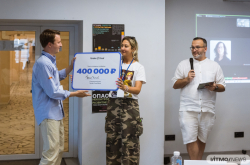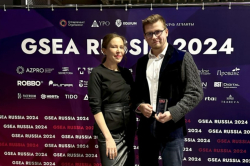What is OLIMP?
OLIMP stands for Open Laboratory of Ideas, Methods and Practices. It is a joint project by students and professors from ITMO and other universities that presents an open and multi-faceted platform for self-education. The teaching staff here is made up of not only experienced professors, but the students, too. The main goal of the project is to provide the necessary knowledge and tools to implement one’s idea, project or concept to everyone who is interested.
As Kirill Bodrov, one of the project’s leads, explains, the laboratory was first launched four years ago. Back then, the students realized that they lack the practical experience and skills required to launch projects. Their solution was to organize regular meetings after classes. After a while, the club grew beyond robotics and became a laboratory that works in more than ten fields of science, including optics, physics, engineering, programming, microelectronics, biotech and web development. Today it is a sort of a cooperative construction bureau open to everyone regardless of their age, where people can work on their own ideas or join others’ projects.

OLIMP Laboratory
What is the purpose of such laboratories?
These days practically every university in St. Petersburg has its own FabLabs, rapid prototyping labs, educational centers – there are plenty of opportunities for those who want to work in science and technology. What is their main purpose?
First off, these laboratories provide an opportunity to prove the viability of concepts. They allow creators to quickly produce prototypes of their projects and test their future products in the early stages without even needing to find or buy the necessary equipment. Everything is usually provided by a FabLab that already has access to various modern tools. Oftentimes, the equipment itself is the product of other lab members and is tailored to specific or obscure needs.
“In most cases, the FabLab infrastructure is more than enough for the creation of a prototype that would prove the feasibility of your concept. Manual creation can be complicated – it’s much easier to upload your blueprints and use the provided equipment to create a final product ready for presentation. It also saves time. There are things that can only be made with a 3D-printer. And since the laboratories today give you the opportunity to use these devices, you won’t have to spend your own resources on acquiring one,” – says Bodrov.

ITMO University's FabLab
Secondly, FabLabs are also, in a way, educational centers where you can put your theoretical knowledge to the test and learn from the more experienced members.
Thirdly, such places are exactly where you should go to find a team for your project or join someone else’s. People there cooperate on mutually beneficial terms and by taking into account everyone’s skills. For instance, if your project requires a 3D modeler, you’ll be able to add one to your team on bartering terms – at some point, they will also expect you to contribute your skills and knowledge to their own work.
How to start a project
1. Basic knowledge. In addition to your project idea, you’ll also need to be familiar with the field in which you’ll be developing your project and equipment needed for it. Learning these things isn’t as hard or time-intensive as it might seem as first. There are a myriad online courses and video-tutorials that will help you get up to speed with the specific areas of knowledge. For instance, if your project requires being able to work with Arduino software, online courses and self-development will be enough – at least during the initial stages. A good tip is to have a friend or colleague to study with to make sure you learn more effectively and don’t abandon your education halfway through.

Geek Picnic 2017
“Skills are more accessible than ever. Even schoolkids know how 3D printers work. A lot of people are familiar with using Arduino. The only thing that might stop you from acquiring new skills is not knowing just how open and accessible everything is, or, in the worst case, lack of self-confidence. We encounter so many people who think they’re not capable of something. It’s important to let them know that you can learn everything – you might not even need to get out of the house,” – he explains.
2. Practice. When you come to the laboratory, you can use everything you’ve learned at the self-education stage. Communication is key here. As you become a part of a community of enthusiasts, you acquire new experience, learn faster and more efficiently and, thanks to timely advice, avoid the mistakes you would have had to deal with if you’d been working on your own.
3. Team. You can assemble a team at the lab or at any of the countless scientific festivals. For instance, OLIMP regularly takes part in annual events such as Geek Picnic and VK Fest that bring together thousands of developers, enthusiasts and regular fans of science and technology. By meeting people at festivals, you not only acquire useful contacts, but also stay up to date with the latest ideas and products that your colleagues from other labs are working on.
What’s next?

Kirill Bodrov
If you’ve already tested your idea, built a prototype and want to develop your idea further or start to seek funding, you should take a look at the competitions and grants for R&D and research projects. It’s important to note that, at this stage, you should have a clear and coherent plan for implementing your idea as a specific product ready for larger-scale production. This includes: a properly developed design specification (it’s better not to take any chances with that; if you can’t make one yourself – find a professional to do it, advises Kirill); a completed patent search (an obligatory requirement for R&D) or a registered trademark; a draft and a technical design and, finally, a prototype model that has been properly tested.
Innovative infrastructure
One can also develop their idea into a full-on project at business accelerators and technoparks, especially now that so many of those have been launched in St. Petersburg as of late. In other countries, reputable accelerators that have helped launch multi-million startups attract a great deal of media and investor attention. Taking part in such programs helps residents build up their image and facilitates media involvement. Mr. Bodrov also advises entrepreneurs to personally get to know each of the many possible offers: speak to those who work there, evaluate the conditions and the history of each venue.

“There are more than 100 places that identify themselves as business incubators – that’s just in St. Petersburg alone. Among them are no more than a dozen that actually work. If you’re looking for a place where you’d want to develop your ideas, don’t feel reluctant or awkward about taking a closer look: asking around, talking to those who work there and testing the local infrastructure for yourself. As soon as you do that, you’ll know just what you’re getting into. Even a basic set of human communication skills can help you avoid a great deal of trouble,” – he concludes.
To better acquaint yourself with OLIMP’s work and to find out more about their projects and schedules, you can come to one of the introductory meetings on September 14 at 17:00 in ITMO’s Main Building at Kronverksky 49, Room 285 or on September 15 at Lomonosova 9, room 2503.






